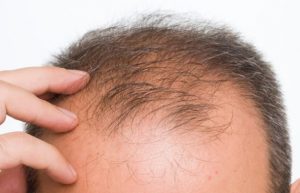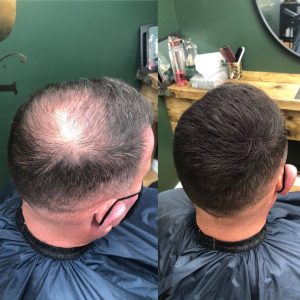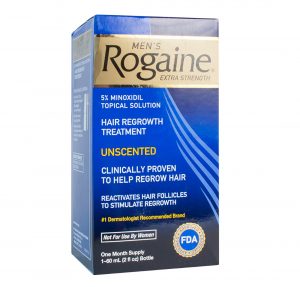Hair transplant procedures can thicken hair by adding healthy follicles to areas experiencing hair thinning.
During the first few months following the procedure, patients may experience temporary hair loss, known as “shock loss”.
However, the transplanted hair eventually begins to grow and fill previously thin areas.
Hair transplant procedures are usually permanent solutions for hair loss and hair thinning.
Surgeons remove grafts containing one to three hair follicles from an area called the donor site.
The donor hair follicles typically come from the back of the head where people are less likely to experience hair loss.
The thicker, healthier hair is then transplanted around the crown or other areas that suffer from balding or thinning.

How to Thicken Hair After a Hair Transplant
Shortly after the procedure, some patients experience “shock loss,” which is a condition that causes transplanted hair to shed.
Shock loss often occurs about one to two weeks after the procedure. New hair often appears within several months.
However, patients can follow specific recommendations to reduce the risk of shock loss and promote thicker hair.
The following options may help thicken hair after a hair transplant:
- Shampoos
- Thickening hair sprays
- Hair fibers
- Laser caps
- Rogaine
- Finasteride

Only about 15% of patients experience significant shock loss.
However, surgeons often recommend that all patients use caution when caring for the hair to minimize the risk of damage to the delicate follicles. Your hair needs time to recover from the surgery.
Use Hair Thickening Shampoos to thicken hair after a transplant
Hair shampoos may strengthen hair, which helps to create a thicker look.
These shampoos tend to include key nutrients that improve the health of hair follicles. Common ingredients include keratin, vitamin B5, biotin, zinc, and natural oils from plants, such as coconut.
The use of hair-thickening shampoos is recommended for maintaining the health of your existing and transplanted hair. However, surgeons recommend that you wait two or three days after the transplant to resume washing your hair.
You also need to start gently with a mild shampoo.
Most clinics may suggest that you wait until about a week after the treatment before using hair products for thickening.

Use Hair Sprays or Fibers to Thicken hair after a transplant
Hair sprays and fibers are often used to achieve the appearance of fuller hair with less effort. Unlike hair thickening shampoos, hair thickening sprays powder fibers are designed to instantly add volume and texture to your scalp.

These products include compounds that adhere to your existing hair for a fuller look.
The fibres bind to the hairs on your head. However, you need to carefully apply the product to achieve the best results.
Hair thickening sprays and fibres are available in a variety of colours, allowing you to match the colour of your existing hair.
You also need to apply the right amount, as adding too much of the product limits its effectiveness.
The results are also temporary. The hair spray or powder fibres require reapplication every day or two. Many patients who use hair fibres also use hair-thickening shampoos.
Laser Caps May Stimulate Hair Growth
Laser caps are used to shower the scalp and hair follicles with low-strength infrared light.
Studies have found that wearing laser caps for multiple, short sessions each day may help increase hair thickness and combat the effects of alopecia. However, laser caps do not provide instant results.
Clients typically need to use the laser cap daily for several months before noticing hair regrowth.
Rogaine or Finasteride to thicken hair
Rogaine and finasteride are two of the leading medications for combatting male pattern hair loss.
Rogaine was the first product approved by the US Federal Drug Administration (FDA) to treat hair loss in both men and women.
The product contains minoxidil, which helps increase the health and size of hair follicles, resulting in fuller hair.

Finasteride is a type of medication that blocks the production of a male hormone responsible for damaging hair follicles.
Unlike Rogaine, finasteride cannot be used by women. It is also available by prescription only.
As with laser caps, Rogaine and finasteride do not instantly create thicker hair. Rogaine is applied topically each day while finasteride is taken orally.

Pharmacist with special interest in hair loss and hair transplantation.
Read my book on hair transplants in Turkey on Amazon:
https://track.more-info.co.uk/amazon/authorprofile

